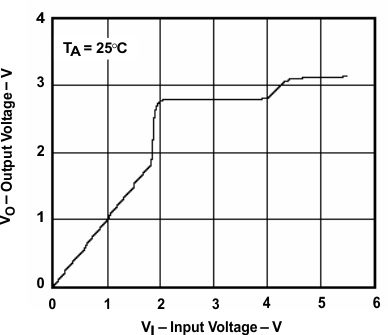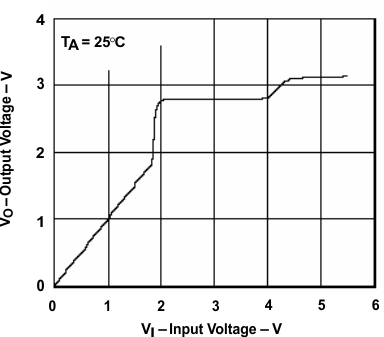SCDA008C June 2021 – November 2021 CD4052B , TS3A225E , TS3A44159
- Trademarks
- 1Introduction
- 2Semiconductor Switches
- 3Basic Signal-Switch Structures
- 4Key Concerns in Digital-Switch Applications
- 5Signal Switch Families
- 6Applications
- 7Conclusion
- 8References
- 9Revision History
-
A Test
Measurement Circuits
- A.1 Measurement Setup for ron
- A.2 Measurement Setup for VO vs VI Characteristics
- A.3 Voltage-Time Waveform Measurement (Switch On)
- A.4 Voltage-Time Waveform Measurement (Switch Off)
- A.5 Output-Skew Measurement
- A.6 Simulation Setup for Undershoot Measurement
- A.7 Laboratory Setup for Attenuation Measurement
- A.8 Laboratory Setup for Off Isolation Measurement
- A.9 Laboratory Setup for Crosstalk Measurement
5.4.1.1 VO vs VI
Figure 5-23 and Figure 5-24 show the output voltage vs input voltage (VO vs VI) characteristics of the CB3T3306 for different values of VCC. The rapid increase in output voltage is due to the control circuit sensing the output voltage and pulling it high, close to the VCC level. The slope of this rapid rise in the curve depends on the output current being drawn from the switch.
 Figure 5-23 VO vs VI in the CB3T3306 at IO = –1 µA (VCC = 2.3 V)
Figure 5-23 VO vs VI in the CB3T3306 at IO = –1 µA (VCC = 2.3 V) Figure 5-24 VO vs VI in the CB3T3306 at IO = –1 µA (VCC = 3.0 V)
Figure 5-24 VO vs VI in the CB3T3306 at IO = –1 µA (VCC = 3.0 V)